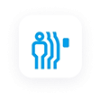With the advent of the Industrial Internet of Things (IIoT), cloud computing, augmented reality (AR), and other innovative technologies, manufacturing facilities all over the world began to rely more on data, robotics, and automation. The factories that utilize these innovative technologies are known as smart factories.
Among these technologies, industrial robots play a major role in smart manufacturing facilities. Industrial robots are autonomous machines that can perform various tasks without human intervention based on their hardware, sensing, and control capabilities.
However, a sensor is a key component that enables these capabilities in robots. These sensing devices also play a vital role in eliminating potential hazards and risks to humans working alongside industrial robots.
Let’s find out how these sensors work and their role in keeping a workplace safe.
What are Sensors?
Robots require vast amounts of data or information about themselves and their environment to function safely and effectively. Sensors in industrial robots have the same function as sensory organs in humans.
These devices embedded in industrial robots collect data and process it in a controller or processing device to enable robots to analyze their working conditions and surroundings.
Sensor technology empowers industrial robots to safely navigate their paths, perceive changes in their work environments, and make accurate decisions in complex situations, just like humans.
How Sensors Can Improve Workplace Safety
Safer human-robot collaboration
Sensors help robots work alongside humans without colliding with each other. If a sensor fixed on an industrial robot recognizes a chance of collision with a human worker or operator, it will automatically slow down, stop, or change its path to avoid the collision.
This is typically useful for Autonomous Mobile Robots (AMRs) employed in industrial settings such as warehouses. Using LiDAR sensors, these autonomous vehicles can safely move within the defined work area by continuously scanning objects around their path.
These sensing devices also eliminate the need for safety fences and interlocks, lowering the costs of manufacturing or other industrial processes. In addition, safe human-robot collaboration improves the productivity of an industrial facility.
Enable robots to perform dangerous and repetitive tasks
Sensor technology gives industrial robots the ability to carry out dangerous yet repetitive tasks, such as working at heights and in confined or infectious areas. They can also carry out tasks that stress the human mind and body.
The most popular example is an industrial robotic arm that can move in different directions and can carry out tasks such as welding, picking and placing, packaging, and material handling without human intervention. Depending on the application, these arms utilize a range of sensors such as proximity, infrared, temperature, and force/torque sensors.
Sensors enable robot learning
Sensors collect vast amounts of data and provide information to an industrial robot that has a specific task, such as controlling the temperature of a facility or monitoring the motion of other machines. This data also helps facilitate shared learning among robots as well as between humans and robots.
Robot learning, sharing information, and learning experiences using data from sensors make industrial robots safer, more intelligent, and more adaptable in different work environments.
Powering AI models
With advancements in Artificial Intelligence (AI) technology, industrial facilities can merge sensor technology and robotics in innovative ways, such as the Internet of Robotic Things (IoRT).
IoRT has augmented sensing capacity, which helps them precisely control their actions and navigation in extremely hazardous working conditions.
In Industry 4.0, manufacturing facilities are increasingly deploying industrial robots to automate all kinds of manufacturing processes. The demand for service robots is rising in technologically advanced countries, along with increased investments in robotic research.
Both developed and developing countries are increasingly adopting robots for defense and logistics. Also, they are becoming common in automotive and medical applications.
All these developments in industrial robotics will result in increased demand for industrial robotic sensors. According to Credence research, revenue from the international market for sensors for industrial robotics is estimated to grow from $1.3 billion in 2021 to nearly $3 billion in 2027.
Hokuyo: Your Partner in Sensor Technology
At Hokuyo, we provide a wide range of sensor products to fit your specific automation and robotics applications.
Our sensors come with cutting-edge technology and compact designs. These include light detection and ranging (LiDAR) or obstacle detection, crane collision avoidance, safety laser scanners, optical data transmission, and laser distance sensors.
Contact us to get assistance in choosing the right sensor for your unique industrial robotics application.

 Factory Automation
Factory Automation Logistics Automation
Logistics Automation Process Automation
Process Automation Crane Collision Avoidance
Crane Collision Avoidance LiDAR Sensors
LiDAR Sensors Safety Laser Scanners
Safety Laser Scanners Optical Data Transmission
Optical Data Transmission Hot Metal Detectors
Hot Metal Detectors Laser Distance Sensor
Laser Distance Sensor Blog
Blog Whitepapers
Whitepapers Case Studies
Case Studies Infographics
Infographics